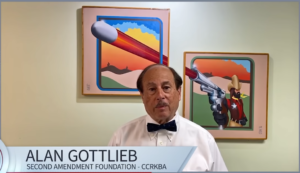
By Dave Workman
Editor-in-Chief
As thousands viewed the virtual 36th Annual Gun Rights Policy Conference over the weekend, they heard from Alan Gottlieb, founder of the Second Amendment Foundation and chairman of the Citizens Committee for the Right to Keep and Bear Arms, assure the audience, “It has been quite a year for the gun rights movement.”
But, he cautioned, “Like a football game where the rules have been changed, it doesn’t matter how many points we score, if they score one touchdown, they win and we lose our rights forever.”
That sentiment was echoed during the first segment panel discussion on the history of the Second Amendment by Dave Kopel, research director for the Colorado-based Independence Institute. Kopel provided historical insight on the Second Amendment as an individual right recognized far back in the 19th Century, and he cautioned listeners, “As it turns out, civil rights are not something you win once and for all, and then you’re set, there’s a continuing struggle to fight for civil liberties.”
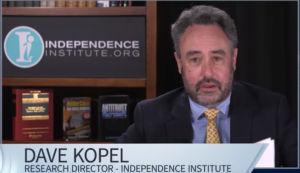
The conference, online on several different platforms including YouTube and Facebook, was viewed by several thousand people and it is still available for viewing online at leisure. The YouTube platform has five segments: Part One, Part Two, Part Three, Part Four and Part Five.
Gottlieb opened the conference with the good news, noting, “Our opponents have thrown everything they had at us, plus the kitchen sink.”
However, the gun rights movement has been able to stop federal legislation, and prevent Joe Biden from installing an avowed gun control proponent as head of the Bureau of Alcohol, Tobacco, Firearms and Explosives.
“We just recently stopped the David Chipman nomination to run the Bureau of Alcohol, Tobacco and Firearms, a great victory for the gun rights movement,” Gottlieb stated. “The gun rights movement 1, the Biden gun ban lobby 0.”
The past 20 months have seen “a record number of new gun buyers and gun owners,” he continued. Many of those individuals “are getting very engaged in the gun rights movement,” he said, noting that television advertising efforts by SAF and CCRKBA have “brought in thousands of new members and supporters.”
“We now have more Second Amendment sanctuary counties than ever before,” Gottlieb reported. “We have more states with constitutional carry.”
And there is a gun rights case headed to the U.S. Supreme Court involving the New York State Rifle & Pistol Association’s challenge of that state’s gun permitting laws.

Cheryl Todd, host of Gun Freedom Radio, looked back on the history of women and gun ownership, noting that even before women could vote, they exercised the right to keep and bear arms. She lamented, however, that over the past 100 years, since women achieved the right to vote, “Too many women, and men alike, have used their vote to suppress and infringe on certain parts of our Bill of Rights, including our right to keep and bear arms.”
As a result, gun owners in the 21st Century are now trying to “recover and reclaim that right,” she said.
“Women do own guns, carry guns and we value our right to do so,” Todd declared.
She was followed by one of the pioneers of Second Amendment scholarship, David Hardy, who explained how the scholarly movement began 40 years ago. He researched the amendment, discovering in the process, “there was a very good case for the Second Amendment being an individual right.”
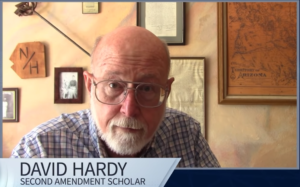
SAF eventually started scholarship symposiums that brought together other pioneers on the subject including Stephen Halbrook, Joyce Lee Malcolm and the late Don Kates. Before long, other researchers began paying attention and writing, including Sanford Levinson with his Yale Law Review article headlined “The Embarrassing Second Amendment,” Lawrence Tribe and other prominent names who concurred the right to keep and bear arms is an individual right.
Kevin Dixie, a civil rights activist and firearms instructor, examined gun rights from the Black perspective, discussing the Rosewood, Florida incident in 1923 and the importance of gun ownership within the Black community.
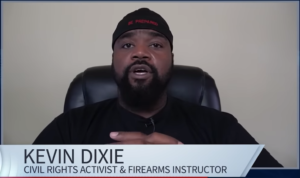
“There’s a falsehood in believing that Black Americans are vehemently anti-gun because we challenge a large portion of Black Americans who vote for a party that is known for supporting gun control,” he said. “We are an ethnic group of individuals who really have no choice but to believe in gun rights and preservation.”
Kopel discussed the Dred Scott decision by the U.S. Supreme Court in the mid-1800s which identified the privileges and immunities of U.S. citizens, including the right to bear arms. Today, the debate is still very much alive, and headed back to the Supreme Court in November.
“The plaintiffs in the New York State Rifle & Pistol Association are fighting over the same kind of issue that was going on in Dred Scott,” Kopel contended.
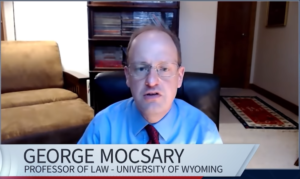
George Mocsary, a University of Wyoming law professor, took the history of self-defense law back to ancient Greece, mentioning the writings of Aristotle, Cicero and Plato, and how the philosophies of their time came into play at the time of the Founders and post-Revolution.
“Thomas Jefferson,” Mocsary observed, “described Aristotle and Cicero as being among the major sources of the American consensus on rights and liberties.”
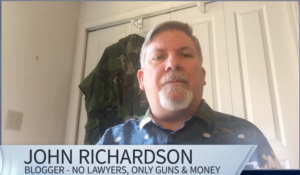
John Richardson, blogger at “No Lawyers, Only Guns and Money,” rounded out the presentation with a discussion on neutrality of Sweden and Switzerland.
He provided displays of maps showing how both nations were surrounded during WWII by German or its occupied nations. He then also showed three different rifles that were available to the armies of the neutral armies.
SAF and CCRKBA are planning to be back to their regular move of holding live conferences at some location in 2022.



